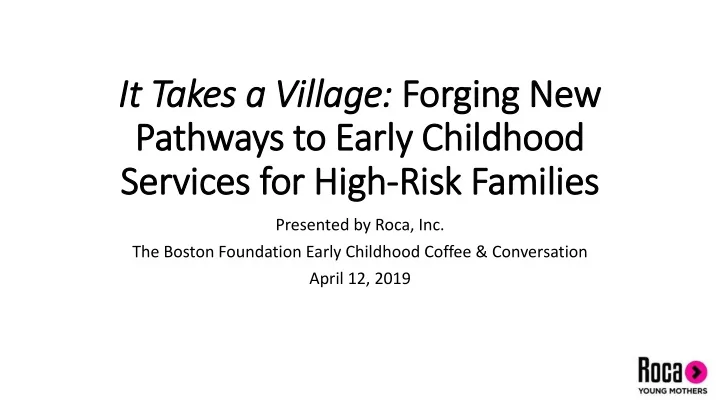

It It Takes a Vill illage: Forging New Pathways to Early Childhood Services for Hig igh-Risk Families Presented by Roca, Inc. The Boston Foundation Early Childhood Coffee & Conversation April 12, 2019
Who Are Greater Boston’s Highest -Risk Families? • Single mothers ages 15-24 with children ages 0-6 • Limited or interrupted education • Little employment experience • Multiple systems involvement, history of victimization, history of trauma, and housing instability • Their children are most vulnerable to adverse experiences, developmental concerns, and long-term poverty, and are set up to repeat intergenerational cycles of violence and incarceration
Where Do They Live? • Move between Chelsea, East Boston, Everett and Revere – 3 rd highest teen pregnancy rate • Instability due to rising housing costs and increased threat of deportation • Lack of coordinated services and gap in access to quality early childhood services • Disinclined to seek out services for themselves or their children due to culture, stigma, and fear
A Population No One Else Is Serving Parent Factors United States Massachusetts MA Home Visiting Roca HRYMP Substance Abuse Binge drinking 37.6% Binge drinking 50.8% 57% Illicit drugs 23.7% Illicit drugs 33.4% History of Abuse 64% 85% Systems Involvement 7.2% 4.1% 4% (DCF) 56% Not Completed HS 10.8% 9.3% 59% 93% No Employment History 83% Immigrant to the US 9.8% 13% 12% 56% Undocumented 3.3% 3.8% >33% Child Factors Child Poverty 20.3% 14.6% 100% 2+ Child ACES 19.3% 15.4% 100% (4+)
East Boston Young Parent Partnership
Partnership Goals 1. Identify the most challenging barriers that prevent East Boston’s young parents from accessing high-quality services for children aged 0-3 and which can potentially be improved by cross-sector partners changing the way they work together. 2. Pilot actual practice and/or policy changes to improve or streamline access to early childhood services. 3. Develop actual practice and policy changes to systematically address these barriers, while addressing any systemic (e.g., political, legal, or policy-related) obstacles.
Survey of East Boston Young Mothers Parent Profile Challenges/Barriers • 82 mothers with 123 children 0-6 • 30% do not access services due to fear of authority figures • 27% ages 16-20, 49% 21-24 • 12% find staff to be friendly and • 56% living in East Boston unresponsive • 76% on WIC • 12% find information to be confusing • 23% utilizing health/mental health • Only 16% have trusted service services provider they are comfortable with • 10% utilizing licensed child care, 45% • Housing and DTA benefits most sought have children at home with them after services/resources • 8% in Home visiting, 2% in Head Start, 9% in Early Intervention
Pilot East Boston Young Parent Family Night • 24 mothers age 16-25 with 38 children ages Prenatal-5 • 60% living in East Boston • 10 service providers, including: • Boston Basics – 7 referrals • BPS School Finder • Child Development & Education (Family child care) – 12 referrals • Community Advocacy Program (domestic violence) • Countdown to Kindergarten – 3 referrals • Department of Transitional Assistance – 7 referrals • East Boston Neighborhood Health Center – 7 referrals • East Boston Social Center – 1 referral • North Suffolk Early Intervention – 4 referrals • Roca – 9 referrals • WIC – 9 referrals
Pilot East Boston Young Parent Family Night
Anticipated Outcomes Family-focused service providers increase or improve the quality of co-case management around child programming; DCF case workers work upstream to prevent developmental delays by engaging parents more intentionally in child development activities in the home; By sharing strategies across partners and sectors , our agencies learn to collectively deliver high-quality, low- or no-cost early childhood services in informal or non-center-based settings; State-level data systems (DTA, DCF, DPH) communicate differently with community-based service providers to ease the transition of families across systems, communities, and childcare providers; and/or, Local and/or state level policy changes allow this region’s highest -risk families – socially vulnerable, immigrant youth with one or more children ages 0-3 – to access public financial assistance and/or other systems of care for their children.
Results/Impact Lessons learned by partners: 1. High-risk young families need to be connected to resources • For example, understanding TAFDC 2. Local providers need to learn more about each other’s work • Financial resources allowed providers to come together 3. Typical outreach strategies do not work for this population • They will not RSVP! • Only 8 out of the 19 participants responded to follow-up
High-Risk Young Families – What Does it Take? For people who are not ready, willing, or able…. …we must think differently, feel differently, and do differently.
In order to support high-risk children, we need to support their parents first. Children of high-risk young families: • Are among the most disadvantaged, in the short and long term • Are unable to realize the benefits of formal Early Care & Education • Are most positively impacted by a high- quality, stable home environment Additionally: • Poverty and stress are linked to less responsive parenting, which is a risk factor for decreased child executive functioning and worsened motor and social-emotional competence in children
Thank you! Questions? Please contact Sunindiya Bhalla Chief of Two-Generation Strategies & Programs Roca, Inc. Sunindiya_Bhalla@rocainc.com
Recommend
More recommend